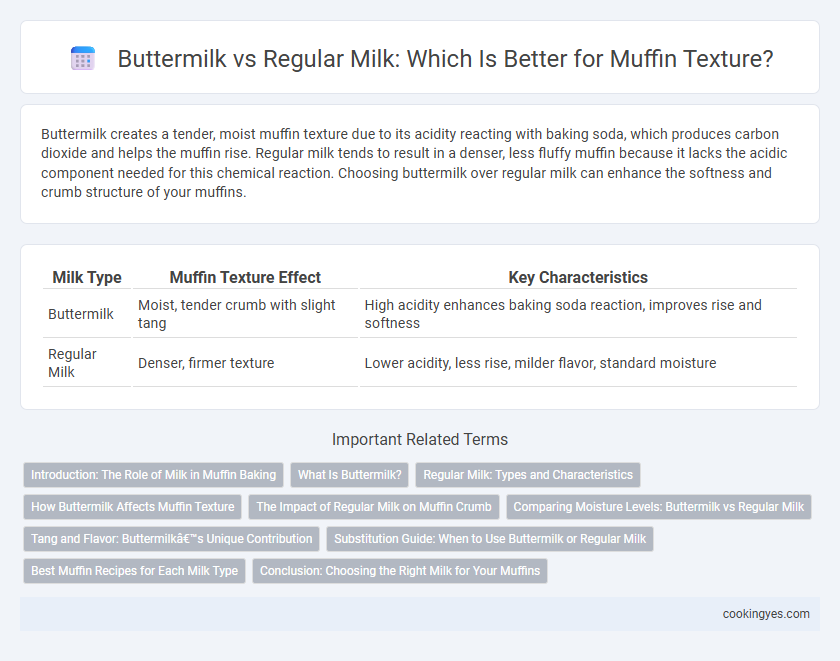Buttermilk creates a tender, moist muffin texture due to its acidity reacting with baking soda, which produces carbon dioxide and helps the muffin rise. Regular milk tends to result in a denser, less fluffy muffin because it lacks the acidic component needed for this chemical reaction. Choosing buttermilk over regular milk can enhance the softness and crumb structure of your muffins.
Table of Comparison
| Milk Type | Muffin Texture Effect | Key Characteristics |
|---|---|---|
| Buttermilk | Moist, tender crumb with slight tang | High acidity enhances baking soda reaction, improves rise and softness |
| Regular Milk | Denser, firmer texture | Lower acidity, less rise, milder flavor, standard moisture |
Introduction: The Role of Milk in Muffin Baking
Milk plays a crucial role in muffin baking by providing moisture, enhancing texture, and contributing to leavening through its interaction with baking agents. Buttermilk's acidity reacts with baking soda to create a lighter, fluffier crumb, while regular milk offers a more neutral pH, resulting in a denser, sturdier muffin structure. Choosing between buttermilk and regular milk directly impacts the tenderness, rise, and overall texture of the final muffin.
What Is Buttermilk?
Buttermilk is a fermented dairy product with a tangy flavor and thicker consistency compared to regular milk, making it ideal for enhancing muffin texture. It contains lactic acid, which reacts with baking soda to create carbon dioxide bubbles, resulting in a lighter and fluffier muffin crumb. Using buttermilk instead of regular milk improves moisture retention and adds a subtle tang that elevates the overall taste and tenderness of muffins.
Regular Milk: Types and Characteristics
Regular milk, including whole, 2%, and skim varieties, impacts muffin texture by providing varying fat levels that influence moisture and crumb density. Whole milk's higher fat content contributes to a tender, moist crumb, while lower-fat options like skim produce a lighter, less rich texture. The protein content in regular milk aids gluten development, affecting the muffin's structure and rise during baking.
How Buttermilk Affects Muffin Texture
Buttermilk enhances muffin texture by adding acidity, which reacts with baking soda to create a tender and moist crumb. Its thicker consistency contributes to a denser, richer muffin compared to the lighter texture achieved with regular milk. The lactic acid in buttermilk also improves flavor depth and helps retain moisture during baking.
The Impact of Regular Milk on Muffin Crumb
Regular milk contributes to a lighter, less dense muffin crumb compared to buttermilk, due to its neutral pH and lower acidity. The reduced acidity in regular milk results in weaker gluten structure development, producing a more tender, airy texture. Its higher moisture content also aids in achieving a softer crumb with finer air pockets.
Comparing Moisture Levels: Buttermilk vs Regular Milk
Buttermilk contributes higher moisture levels and acidity, enhancing muffin tenderness and crumb softness compared to regular milk. Regular milk contains less acidity and moisture, resulting in a denser and less moist muffin texture. The lactic acid in buttermilk also interacts with baking soda to create a lighter, fluffier muffin structure.
Tang and Flavor: Buttermilk’s Unique Contribution
Buttermilk imparts a distinct tangy flavor to muffins that regular milk cannot replicate, enhancing the overall taste profile with subtle acidity. The acidity in buttermilk reacts with baking soda, creating carbon dioxide that contributes to a tender, moist crumb texture. Bakers prefer buttermilk for its ability to balance sweetness and enrich flavor depth, making muffins more flavorful and soft compared to those made with regular milk.
Substitution Guide: When to Use Buttermilk or Regular Milk
Buttermilk lends muffins a tender crumb and a slight tang due to its acidity, which reacts with baking soda to create a fluffier texture, making it ideal for rich, moist muffins like blueberry or chocolate chip. Regular milk offers a neutral flavor and works well in recipes relying on baking powder for leavening, maintaining a denser, finer crumb suitable for simpler, less tangy muffins. Use buttermilk when you want a moist, airy texture and enhanced flavor, but substitute with regular milk if buttermilk is unavailable, adding a tablespoon of lemon juice or vinegar per cup to mimic acidity for best results.
Best Muffin Recipes for Each Milk Type
Buttermilk enhances muffin texture by providing a tender crumb and slight tang, ideal for recipes like blueberry or lemon poppy seed muffins that benefit from a moist, dense finish. Regular milk produces lighter, fluffier muffins suitable for classic chocolate chip or banana nut recipes where a more delicate crumb is preferred. Choosing buttermilk or regular milk depends on the desired muffin texture and flavor profile, making both essential for optimizing a variety of best muffin recipes.
Conclusion: Choosing the Right Milk for Your Muffins
Buttermilk enhances muffin texture by creating a tender crumb and slight tang due to its acidity, which reacts with baking soda for better rise and softness. Regular milk produces a denser, more neutral-flavored muffin with a firmer texture. Choosing buttermilk is ideal for moist, fluffy muffins, while regular milk suits recipes requiring a subtle flavor and sturdiness.
Buttermilk vs Regular Milk for Muffin Texture Infographic

 cookingyes.com
cookingyes.com